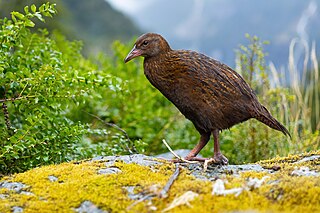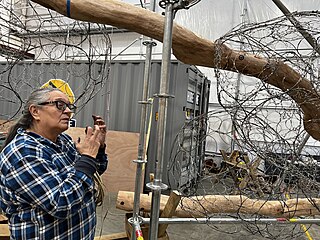
The weka, also known as the Māori hen or woodhen is a flightless bird species of the rail family. It is endemic to New Zealand. Some authorities consider it as the only extant member of the genus Gallirallus. Four subspecies are recognized but only two (northern/southern) are supported by genetic evidence.

The Museum of New Zealand Te Papa Tongarewa is New Zealand's national museum and is located in Wellington. Usually known as Te Papa, it opened in 1998 after the merging of the National Museum of New Zealand and the National Art Gallery. An average of more than 1.1 million people visit every year, making it the 58th-most-visited art gallery in the world in 2023. Te Papa operates under a bicultural philosophy, and emphasises the living stories behind its cultural treasures.

Shona Rapira Davies is a New Zealand sculptor and painter of Ngātiwai ki Aotea tribal descent currently residing in Wellington, New Zealand.
Jolene Douglas is a contemporary New Zealand Māori artist who has been exhibiting since 1983. Two of her art works are in the collection of Museum of New Zealand Te Papa Tongarewa. She is currently living in Gisborne and been a curator Tairawhiti Museum since 1995. Douglas was born in 1950 in Matamata, New Zealand.

A tekoteko is a Māori carved human figure that is mounted as a finial, usually above the gable of a Māori building, most commonly a wharenui or a pātaka. It usually stands above the koruru, a carved head mounted where the bargeboards meet at the apex of the gable.

Spelungula is a monotypic genus of South Pacific large-clawed spiders containing the single species, Spelungula cavernicola, or the Nelson cave spider.

The Dominion Museum building on Mount Cook in Buckle Street Wellington completed in 1936 and superseded by Te Papa in 1998 was part of a war memorial complex including a Carillon and National War Memorial.

Māori traditional textiles are the indigenous textiles of the Māori people of New Zealand. The organisation Te Roopu Raranga Whatu o Aotearoa, the national Māori weavers' collective, aims to preserve and foster the skills of making and using these materials.

Muka is prepared fibre of New Zealand flax. Prepared primarily by scraping, pounding and washing, it is a key material in Māori traditional textiles where it is usually used in tāniko or twined weaving. Some varieties produce different grades or quality of muka that result in characteristics such as strength, whiteness or shine.

Toi whakairo or just whakairo (carving) is a Māori traditional art of carving in wood, stone or bone.

Averil Margaret Lysaght was a New Zealand biologist, science historian and artist, best known for her scholarly work on Joseph Banks.

William Beetham was an English-born portrait painter, who painted mainly in the United Kingdom and New Zealand. He exhibited his paintings at the Royal Academy of Arts in London (1834–53) and painted in Hamburg, Copenhagen and at the court of the Tsar in Saint Petersburg. He emigrated to New Zealand in 1855 and became a significant figure as a colonist, pastoralist and portrait artist. He had a society clientele and received commissions to paint portraits of aristocrats and national leaders, including important Māori Rangatira chiefs. Beetham's paintings are in the permanent collection of the National Portrait Gallery, London and Museum of New Zealand Te Papa Tongarewa in Wellington. He was a founder and President of the New Zealand Academy of Fine Arts in 1882. Mezzotint prints of Beetham's drawings are in the permanent collection of the Science Museum, London Beetham's paintings and drawings have also sold at Bonhams auction house.

Ellen von Meyern (1882-1912) was a New Zealand artist who is remembered for her portraits of Maori people.
Maude Burge was a New Zealand painter influenced by James Nairn. She spent time as an expatriate artist specifically in Europe. Burge was a painting companion of Frances Hodgkins who called Maude Burge a "charming changeable woman" in her published letters. They painted together at the Burge family home in St. Tropez and in Ibiza. Burge's paintings are held in the permanent collection of Auckland Art Gallery, the Museum of New Zealand Te Papa Tongarewa, the National Art Gallery of New Zealand, the Fletcher Trust Collection, the National Library of New Zealand and among private art collectors in the northern and southern hemispheres. Burge exhibited her paintings at the New Zealand Academy of Fine Arts.
Jo Torr is a New Zealand artist. Torr's work explores cultural exchange between European and Polynesian peoples through the lens of costume and textile history.
Hannah Eliza Jane Brenkley was a New Zealand artist and craftswoman. She created artworks through carving, needlework, and painting. Her work is in the permanent collections of the National Library of New Zealand, the Museum of New Zealand Te Papa Tongarewa and the Museum Theatre Gallery Hawke's Bay.
Judy Hohaia is a New Zealand Māori weaver from the Te Rārawa iwi. Her work is included in the permanent collection of Museum of New Zealand Te Papa Tongarewa.
Joan Allison Talbot was a New Zealand fashion designer and retailer. Her work is held in the permanent collection of the Museum of New Zealand Te Papa Tongarewa.

Staff gods are sacred objects within the cultural and spiritual practices of the Cook Islands Māori, particularly prominent on the island of Rarotonga. These objects were crafted from wood and adorned with intricate carvings and symbolic designs, combining images of gods with their human descendants. The staffs range in length between 28 inches (71 cm) and 18 feet and were carried and displayed horizontally.

Mrs Humphrey Devereux is a 1771 oil painting on canvas by the Anglo-American painter John Singleton Copley. It is part of the international painting collection of the Museum of New Zealand Te Papa Tongarewa.














